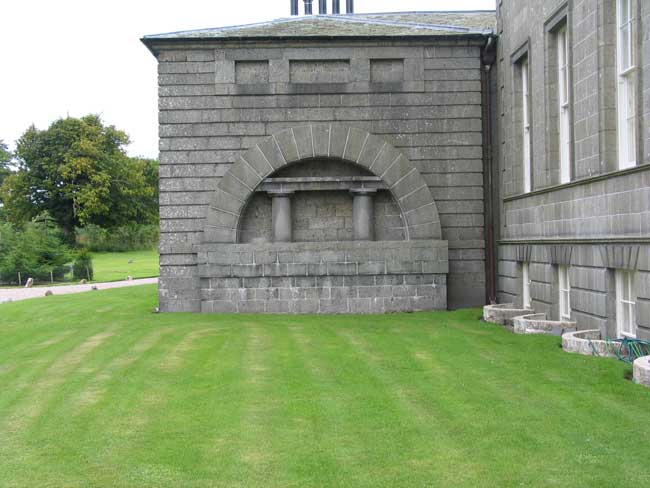Location
Lonmay, nr Fraserburgh
Fraserburgh, Aberdeenshire
OS Map Reference
NK 0383 60
Date
1791-7
Description
Cairness House is considered one of the finest examples
of neoclassical architecture in Britain. The house sits four miles south
of Fraserburgh in the County of Aberdeenshire, looking across to Mormond
Hill. It is the largest and finest country house in Buchan and one of the
great houses of Scotland.
Cairness was built between 1791 and 1797 to designs by architect James
Playfair and replaced an earlier house of 1781 by Robert Burn, which was
largely incorporated into the Playfair scheme. Sir John Soane assisted in
the final stages of the construction following Playfair’s untimely death
in 1794. The park was laid out by Thomas White, a follower of Lancelot
'Capability' Brown.
The building shows a strong influence of the French architects
Étienne-Louis Boullée and Claude Nicholas Ledoux. The design incorporates
a complex mixture of Masonic and pagan symbols as well as many
numerological and architectural conceits. It is a calendar house, and its
ground plan shows an adjoining “C” and “H”, variously standing for
Cairness House and Charles Gordon.
Constructed in finely detailed granite ashlar, Cairness House consists of
a 110-ft main block, flanked by two raised “bookend” wings. A tetrastyle
pedimented Roman Doric porch sits to the centre, its unjointed columns
hewn from menhirs taken from a nearby druids' temple (presumably actually a neolithic recumbent stone circle, possibly one that was at Rora about 6 miles to southeast) . A pair of lower
pavilions with representations of the Masonic Altar adjoin at the back.
From these spans a huge semicircular service wing, with a central bell
tower above a lunette arch, enclosing a courtyard at the rear of the
house. The centre of the courtyard is dominated by a round ice house
modelled on the Temple of the Winds in Athens. The main roof is surmounted
by 51 cast iron chimney cans in the shape of fluted Doric columns.
Cairness House was commissioned by Charles Gordon of Cairness and Buthlaw
and was part of a 9,000-acre estate that included the village of St. Comb’
s and the Loch of Strathbeg, today an important nature reserve. The second
laird, Major-General Thomas Gordon (1788-1841), a good friend of Lord
Byron, was a hero of the Greek Wars of Independence and wrote a celebrated
history of the conflict. The Gordon family sold the estate in 1937 to the
Countess of Southesk.
After the Second World War, the house was used as a farmhouse and
gradually fell into serious decline. The park was destroyed from the early
1950s onwards with the mass clearance of trees in order to reclaim land
for agricultural use. In 1991, the house was listed as a Building At Risk
by the Scottish Civic Trust. A major long-term restoration programme of
the house and grounds was instigated by new owners in 2001. Cairness House
now contains a very fine collection of furniture and works of art and is
open to the public.
Era
1700s
Related Artefacts
Categories
Creator
- James Playfair, Architect
External Links
Unavailable Data
- Related Information
- Information Source
- Iconography
- Photographer
This content was submitted by external contributors and does not necessarily reflect the views of the University of Aberdeen.


